Local markets Vietnam are vibrant windows into the country’s daily life, culture, and cuisine. From the bustling alleyways of Hanoi’s Old Quarter to the floating markets of the Mekong Delta, these traditional hubs offer more than just a place to shop. They’re immersive experiences filled with local flavors, colorful scenes, and authentic human connections.
Whether you’re wandering through mountain markets in the north or spice-scented stalls in the south, Vietnam’s local markets promise unforgettable moments at every turn.
Contents
- 1 Why You Must Visit a Local Markets Vietnam
- 2 Types of Markets You’ll Discover in Vietnam
- 3 List of Best Markets in Vietnam: A Regional Guide
- 4 A Guide to Market Etiquette & Bargaining
- 5 What to Eat & Buy at Vietnam Markets
- 6 Tips for Safe & Savvy Market Exploration
- 7 FAQs About Visiting Local Markets in Vietnam
- 8 Experience Local Markets Vietnam with Expert Guidance
- 9 Embrace Vietnam’s Market Culture
Why You Must Visit a Local Markets Vietnam
Step into any local markets Vietnam has to offer, and you’ll instantly understand why these bustling hubs are the soul of Vietnamese culture. Far more than simple places of commerce, these markets serve as the epicenter of daily life, where generations of families have gathered to trade, socialize, and share stories. Each market reflects the unique regional identity of its location through distinctive produce, traditional crafts, and time-honored recipes passed down through centuries.
The sensory experience of exploring Vietnam markets is unlike anything else – a vibrant tapestry of sights, sounds, and aromatic spells that defines the authentic Vietnamese travel experience. From the melodic calls of vendors announcing their fresh goods to the rainbow of tropical fruits piled high in woven baskets, every corner offers a new discovery. The clatter of chopsticks on bowls, the sizzle of street food on open flames, and the gentle hum of negotiations create a symphony that captures the essence of Vietnam’s spirited culture.
Types of Markets You’ll Discover in Vietnam
Understanding the different categories of best markets in Vietnam will help you plan your cultural exploration more effectively. Traditional daytime markets, known locally as “Chợ,” operate from dawn until late afternoon, offering everything from fresh produce and meat to household goods and clothing. These markets are where locals do their daily shopping, making them perfect for authentic cultural immersion.
Night markets, or “Chợ Đêm,” transform the evening landscape into a foodie paradise. These markets come alive after sunset, specializing in street food, snacks, and casual dining experiences. The atmosphere is more relaxed and social, with families and friends gathering to enjoy meals together under twinkling lights.
The floating markets Vietnam are famous for representing a unique aquatic trading tradition found primarily in the Mekong Delta region. Vendors conduct business entirely from boats, creating a colorful flotilla of commerce on the waterways. These markets require early morning boat trips but offer an unforgettable glimpse into Vietnam’s river-based economy.
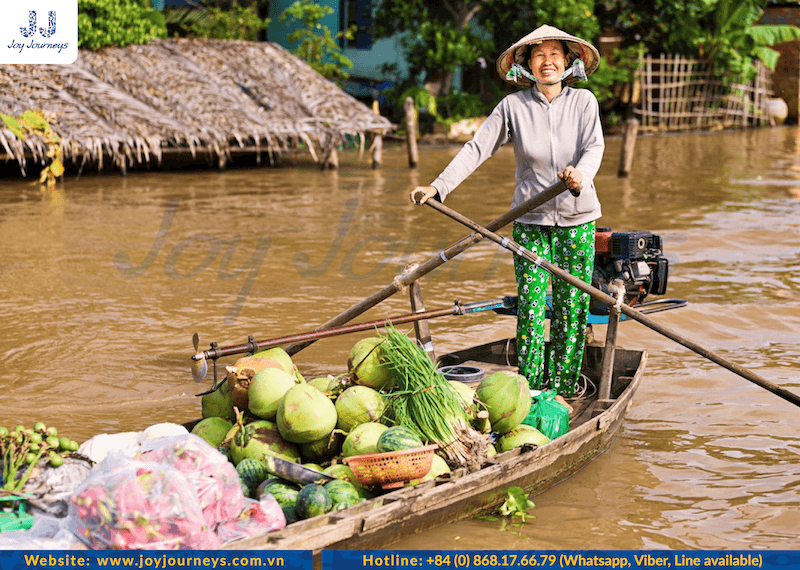
Ethnic minority markets in mountainous regions showcase the incredible diversity of Vietnam’s 54 recognized ethnic groups. These weekly gatherings feature traditional clothing, handicrafts, and local specialties that you won’t find anywhere else. Finally, specialized markets focus on specific goods – flower markets burst with blooms, antique markets house historical treasures, and spice markets tantalize with aromatic herbs and seasonings.
List of Best Markets in Vietnam: A Regional Guide
Northern Vietnam (Hanoi & Mountain Regions)
Dong Xuan Market, Hanoi stands as the largest indoor market in the capital city and one of the most significant Hanoi markets for both locals and tourists. This three-story complex operates as both a wholesale and retail center, making it a fascinating study in Vietnamese commerce. The market’s historical significance dates back over a century, and despite renovations, it maintains its gritty, authentic local atmosphere that provides visitors with an unfiltered look at daily Vietnamese life.
Navigate through narrow aisles packed with everything from fresh seafood and tropical fruits to textiles and electronics. The ground floor focuses on food items, while upper levels house clothing, accessories, and household goods. The market’s authentic local vibe means you’ll encounter fewer tourists and more genuine interactions with Vietnamese vendors.
Bac Ha Market, Lao Cai Province operates as a weekly market that transforms the mountain town every Sunday into a vibrant cultural celebration. This market is extraordinary because it gathers various ethnic minority groups, including the Flower H’mong, Tay, and Nung peoples, each bringing their distinct traditions and products. The market is renowned for its spectacular display of traditional clothing – intricate embroidered fabrics in brilliant colors that reflect each group’s unique heritage.
Perhaps most fascinating is the buffalo trading section, where highland farmers conduct serious negotiations for these valuable work animals. The sight of massive water buffalo being examined and traded provides insight into rural Vietnamese agricultural life that few tourists ever witness.
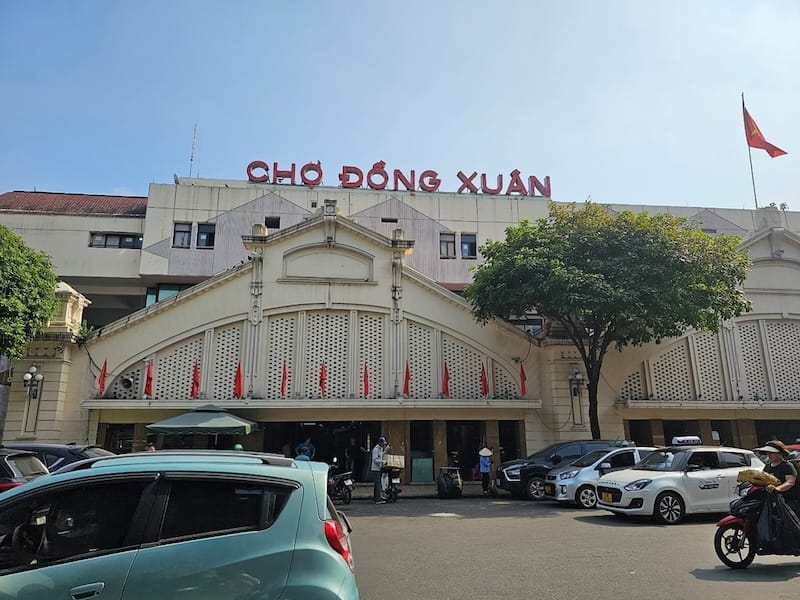
Central Vietnam (Hoi An & Hue)
Hoi An Central Market occupies a beautiful riverside location adjacent to the UNESCO World Heritage Ancient Town, making it one of the most picturesque market experiences in Vietnam. This market specializes in ultra-fresh produce, meat, and fish, with many vendors receiving their goods directly from local farms and fishing boats each morning.
The market’s crowning jewel is its renowned food hall, where local cooks prepare authentic Central Vietnamese specialties. This is the perfect place to try Cao Lầu, Hoi An’s signature noodle dish with its unique chewy noodles, or Mì Quảng, the colorful turmeric-tinted noodle soup. The food hall operates with the efficiency of a well-orchestrated kitchen, with each vendor specializing in specific dishes perfected over generations.
Just a few hours north of Hoi An, Hue’s Dong Ba Market stands as a cultural and culinary landmark in Central Vietnam. Located near the Perfume River, this sprawling market is the largest and oldest in Hue, serving locals since the Nguyen Dynasty. Dong Ba offers an immersive experience into the rhythms of daily life, with its maze of stalls selling everything from handcrafted conical hats and incense to fresh produce, seafood, and dried goods.
For food lovers, Dong Ba is a treasure trove of Hue’s royal-influenced cuisine. Must-try dishes include Bún Bò Huế (spicy beef noodle soup), Bánh Bèo (steamed rice cakes), and Nem Lụi (lemongrass pork skewers). Many of these traditional dishes are served by vendors who have been in the same market spot for decades, offering not just food, but stories passed down through generations. Whether you’re shopping for souvenirs or sampling local delicacies, Dong Ba Market delivers a rich slice of Hue’s heritage.

Southern Vietnam (Ho Chi Minh City & Mekong Delta)
Ben Thanh Market, Ho Chi Minh City serves as both an iconic landmark and major tourist attraction, making it one of the most famous Ho Chi Minh City markets worldwide. This covered market, with its distinctive clock tower, has been serving the city since 1914. During daytime hours, it operates as a traditional market selling everything from souvenirs and textiles to fresh foods and spices.
The real magic happens after sunset when the surrounding area transforms into a bustling street food market. Dozens of food stalls set up on the adjacent streets, creating an outdoor dining experience where you can sample authentic Vietnamese street food while soaking in the energetic atmosphere. Be prepared for confident bargaining – vendors here are experienced with tourists and expect negotiation.
Cai Rang Floating Market, Can Tho represents the crown jewel of floating markets Vietnam offers to visitors. This wholesale market conducts all business on the water, with vendors operating from boats loaded with fresh fruits and vegetables from Mekong Delta farms. The experience requires an early morning boat trip, usually starting before sunrise to catch the market at its most active period.
The market is famous for its “offering pole” system called “cây bẹo,” where sellers hang samples of their goods on tall poles rising from their boats. This ingenious system allows buyers to identify products from a distance while navigating through the crowded waterways. Pineapples, dragon fruit, rambutan, and countless varieties of vegetables create a floating rainbow of fresh produce.
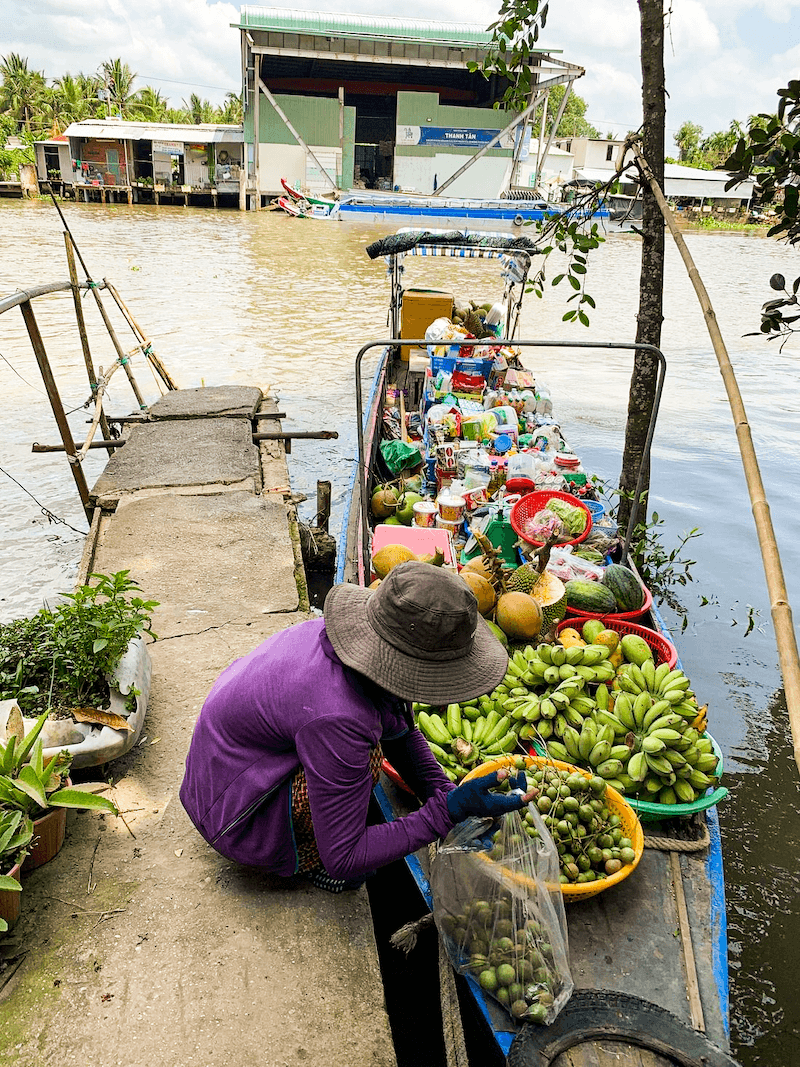
A Guide to Market Etiquette & Bargaining
Understanding how to bargain in Vietnam markets is essential for both cultural respect and getting fair prices. Bargaining is expected and welcomed for non-food items, clothing, souvenirs, and handicrafts, but avoid haggling over food prices, as these are typically fixed and fair. The key to successful bargaining lies in maintaining a friendly, respectful demeanor throughout the process.
The “smile and walk away” technique proves remarkably effective – if the vendor’s price seems too high, thank them politely and begin to leave. Often, they’ll call you back with a better offer. Start by offering about 50-60% of the asking price for souvenirs and work your way up to a mutually acceptable amount.
Learning a few key Vietnamese phrases will enhance your bargaining experience significantly. “Bao nhiêu tiền?” means “How much?” while “Đắt quá!” expresses “Too expensive!” Other useful phrases include “Rẻ hơn được không?” (Can you make it cheaper?) and “Cảm ơn” (Thank you). Even basic attempts at Vietnamese will earn you smiles and potentially better prices.
What to Eat & Buy at Vietnam Markets
Food & Drink to Try
Exploring what to buy at Vietnamese markets begins with the incredible food options available. Phở, Vietnam’s national dish, tastes completely different when prepared by market vendors who have perfected their recipes over decades. The broth is richer, the herbs fresher, and the overall experience more authentic than restaurant versions.
Bún chả offers another must-try experience – grilled pork served with rice noodles and fresh herbs, typically accompanied by a sweet and tangy dipping sauce. Bánh mì from market stalls often surpasses those from dedicated shops, as market vendors have access to the freshest ingredients and maintain family recipes passed down through generations.
Fresh fruit smoothies, known locally as sinh tố, transform tropical fruits into refreshing beverages perfect for Vietnam’s warm climate. Watch vendors blend dragon fruit, mango, avocado, or passion fruit with ice and condensed milk to create creamy, satisfying drinks. Vietnamese coffee at markets offers an authentic experience – vendors prepare each cup individually using traditional metal filters, resulting in strong, aromatic coffee that embodies Vietnamese coffee culture.
Souvenirs & Goods to Buy
Traditional conical hats (nón lá) make quintessential Vietnamese souvenirs and serve practical purposes for sun protection. Quality varies significantly, so examine the weaving tightness and overall construction before purchasing. Silk items, including scarves, clothing, and table runners, showcase Vietnam’s long tradition of silk production. Natural silk feels smooth and cool to the touch, while synthetic alternatives feel rougher and warmer.
Vintage propaganda posters have become increasingly popular among international visitors, offering glimpses into Vietnam’s complex political history. Coffee beans from highland regions like Dalat make excellent gifts for coffee enthusiasts back home. Vietnamese coffee culture emphasizes robusta beans, which produce stronger, more bitter flavors than arabica varieties common elsewhere.
Spice packages allow you to recreate Vietnamese flavors in your home kitchen. Look for star anise, cinnamon, cardamom, and pre-mixed phở spice blends. Vendors often provide cooking instructions, making these perfect souvenirs for food-loving friends and family.
Tips for Safe & Savvy Market Exploration
Timing your market visits strategically enhances both safety and authenticity. Arriving early, typically between 6-8 AM, allows you to experience markets at their most genuine when locals conduct their daily shopping. Fresh goods are at their peak quality, prices may be slightly lower, and the atmosphere feels less touristy.
Food safety at Vietnam street markets requires common sense precautions but shouldn’t prevent you from enjoying authentic experiences. Choose stalls with high customer turnover, as rapid sales ensure fresher ingredients and shorter cooking-to-consumption times. Observe local eating patterns – if Vietnamese customers frequent a particular stall, it’s likely safe and delicious.
Watch food preparation when possible, ensuring proper cooking temperatures and clean utensil handling. Avoid raw vegetables and fruits you cannot peel yourself, stick to bottled or boiled water, and trust your instincts about cleanliness and freshness.
Security considerations include keeping belongings secure in front-facing bags or pockets, wearing comfortable walking shoes suitable for uneven surfaces, and bringing cash in small denominations for easier transactions. Large bills can be problematic for small vendors who may not have adequate change.
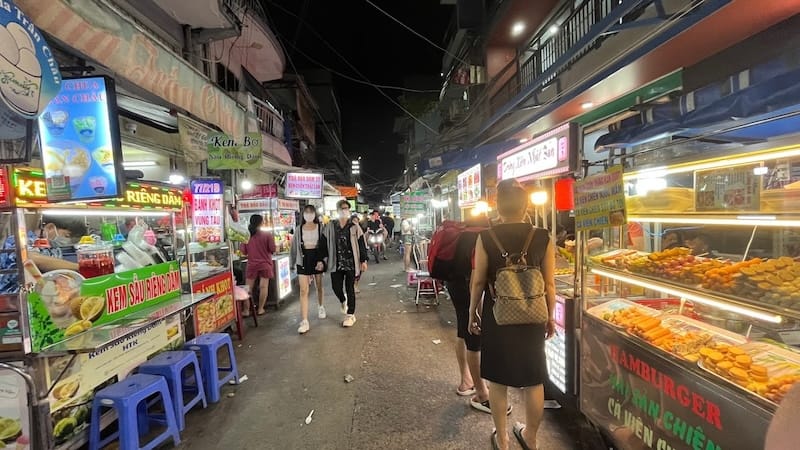
FAQs About Visiting Local Markets in Vietnam
Is it safe for tourists to visit local markets in Vietnam?
Local markets in Vietnam are generally very safe for tourists. Vietnamese people are welcoming to visitors, and violent crime is rare. Exercise normal precautions like keeping valuables secure and staying aware of your surroundings. The biggest risks are usually minor pickpocketing in crowded areas or accidentally eating something that doesn’t agree with your stomach.
Do I need to speak Vietnamese to shop at the markets?
While Vietnamese language skills are helpful, they’re not essential for market shopping. Many vendors in tourist areas speak basic English, and pointing, gesturing, and calculator-based price negotiations work effectively. Learning basic numbers in Vietnamese proves very useful for price discussions.
Should I use cash or a credit card?
Cash is essential for market shopping in Vietnam. Most market vendors operate on a cash-only basis, and credit card acceptance is extremely limited. Bring Vietnamese đồng in small denominations for easier transactions and bargaining. ATMs are widely available in cities for cash withdrawals.
What is the best time of day to visit most markets?
Early morning (6-9 AM) offers the best market experience for fresh produce and authentic local atmosphere. Vietnam night market food guide experiences typically open around 6 PM and stay active until late evening. Avoid midday visits during hot weather, as markets can become uncomfortably warm and crowded.
Experience Local Markets Vietnam with Expert Guidance
For travelers seeking deeper insights into Vietnam culture through market exploration, professional guided experiences offer invaluable advantages. Joy Journeys provides authentic local market tours that combine cultural education with culinary adventure, ensuring visitors gain meaningful understanding beyond surface-level observations.
Private Saigon “Foodie” By Night Motorbike Tour
This immersive evening adventure takes you through Ho Chi Minh City’s vibrant food scene, including stops at authentic local markets where street food culture thrives. The tour includes visits to Ho Thi Ky Market, a spectacular flower market that transforms into a food haven during evening hours. Experienced guides navigate you through hidden alleys where locals enjoy Banh Xeo and Banh Khot, providing cultural context that independent exploration cannot match.
The motorbike format allows access to narrow market lanes and local neighborhoods typically inaccessible to larger tour groups. You’ll experience seafood markets with fresh clams, squid, and scallops prepared according to traditional recipes, along with authentic Banh Mi from vendors who have perfected their craft over generations. This tour exemplifies things to do in Vietnam that provide genuine cultural immersion.
Private Saigon “Sightseeing” Motorbike Tour
While primarily focused on historical landmarks, this comprehensive tour includes market exploration as part of understanding Ho Chi Minh City’s cultural fabric. The customizable experience concludes with visits to either Ton That Dam old market or Chinatown, both offering distinct market experiences that reflect different aspects of Vietnamese commerce and culture.
These authentic local markets in Vietnam provide context for understanding how traditional commerce continues alongside modern development. Professional guides explain market dynamics, introduce you to friendly vendors, and facilitate authentic interactions that solo travelers often miss due to language barriers.
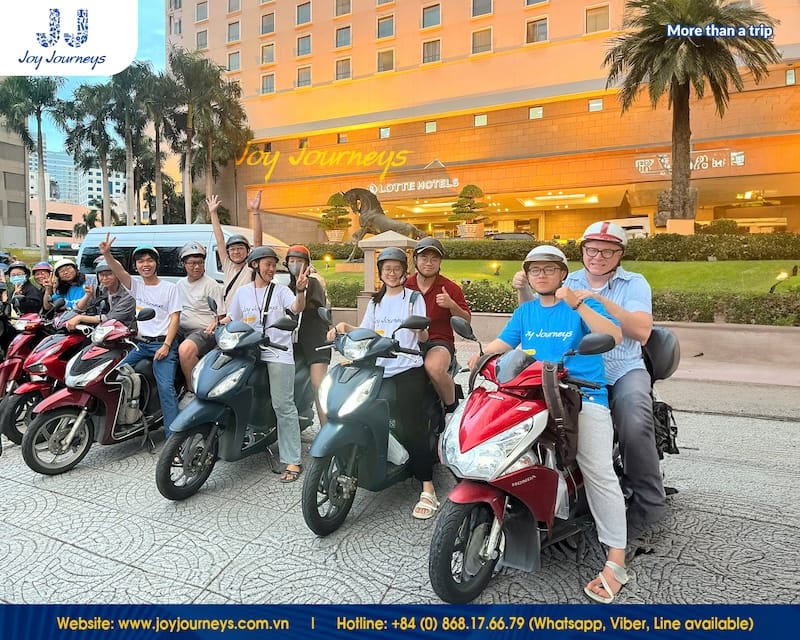
Embrace Vietnam’s Market Culture
Immerse yourself in the authentic culture of Vietnam by adding these incredible local markets to your travel itinerary. Each market offers unique insights into Vietnamese daily life, culinary traditions, and regional characteristics that define this fascinating country. From the floating markets of the Mekong Delta to the ethnic minority markets of northern mountains, these experiences provide connections to Vietnam’s rich cultural heritage that no guidebook can fully capture.
The memories you create while navigating bustling aisles, sampling street food delicacies, and interacting with friendly vendors will become treasured highlights of your Vietnamese adventure. Contact Joy Journeys today to enhance your local markets Vietnam exploration with expert guidance – the experience is sure to be a highlight of your trip that provides lasting appreciation for Vietnam travel guide recommendations and authentic cultural encounters.



Related Posts
Saigon’s “Flower Market Replica”: Where To Find Them
Ho Chi Minh City’s floral charm is not limited to its bustling wholesale markets. Imagine wandering through a place where vibrant petals, fragrant blooms, and the spirit of traditional Vietnamese markets come alive—without the overwhelming crowds. A flower market replica captures that magic, blending the beauty of fresh flowers with the charm of a curated, […]
Is it Safe to Travel to Vietnam Right Now? A Complete 2025 Guide
Vietnam has emerged as one of Southeast Asia’s most captivating destinations, drawing millions of visitors annually with its rich culture, stunning landscapes, and incredible cuisine. However, many travelers still ask: Is it safe to travel to Vietnam right now? This comprehensive guide provides you with everything you need to know about Vietnam travel safety in […]
Ho Chi Minh Cu Chi Tunnels Tour: The Ultimate Guide
The Cu Chi Tunnels stand as one of Vietnam’s most remarkable historical sites, offering visitors a profound glimpse into the ingenuity and resilience displayed during the Vietnam War. For travelers, a Ho Chi Minh Cu Chi tunnels tour represents an essential experience that combines education, adventure, and deep cultural understanding. This comprehensive guide will help […]